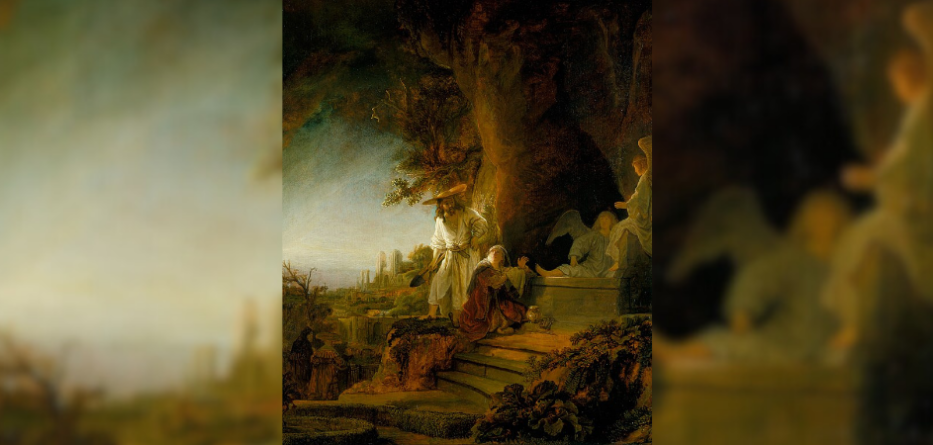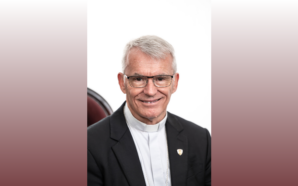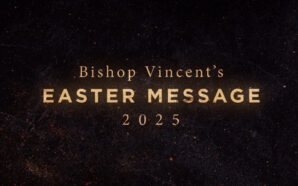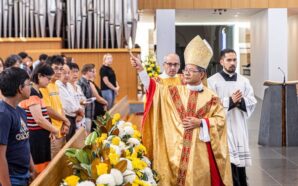Christ and St Mary Magdalen at the Tomb (1638)
Rembrandt van Rijn (1606-1669)
Oil on Panel, 61.0cm x 50.0cm. Royal Collection Trust, UK. Public Domain.
Christ and St Mary Magdalen at the Tomb was painted by Rembrandt van Rijn about halfway through his life (1606–1669). He had been born in Leiden, the youngest son of at least 10 children. He was therefore not expected to carry on the business of his father, a miller. His family was prosperous enough to allow him to pursue a career in painting. At the age of 18, he left for Amsterdam to study under the most important history painter of the day. Returning home, he was noticed by the Prince of Orange who admired his ability to convey feeling to his work, and through his dramatic contrast of light and dark.
We can see all of this in his dramatisation of the Easter event. Most artists tackling this theme choose the moment when Mary Magdalen reaches out to touch the risen Jesus who forestalls her with the words, “Noli me tangere”—“Do not cling to me” (Jn 20:17), meaning, “You have known me in the flesh, now you must know me by faith.” But Rembrandt has subtly depicted the moment before this. “She turned round and saw Jesus standing there, though she did not realise that it was Jesus” (Jn 20:14). She thought the figure she saw was the gardener of the place. Rembrandt presents Jesus in a hat with shovel in hand. The fourth-century monk St Macarius explains: “When a farmer prepares to till the soil, he must put on clothing and use tools that are suitable. So Christ, our heavenly King, came to till the soil of mankind devastated by sin. He assumed a body, and using the Cross as his ploughshare, cultivated the barren soil of man.” Rembrandt accentuates this activity of Christ by highlighting the vegetation in the lower righthand corner.
Mary’s patience is rewarded and she recognises Christ when he calls her by name. His relationship with us is personal—he knows my name.
St Luke mentions that three women went to the tomb to anoint Jesus’ body: “Mary of Magdala, Joanna, and Mary the mother of James” (Lk 24:10). They could not find the body. We can see two of them leaving in the lower left hand of the picture. But Mary of Magdala stays. God does not always answer entreaties immediately. It is always in his time, and requires perseverance from us. Mary’s patience is rewarded and she recognises Christ when he calls her by name. His relationship with us is personal—he knows my name.
We often refer to the “light of faith”. Rembrandt evokes the dawn of Easter Sunday, illuminating the towers of the Jerusalem Temple, the upper half of Christ’s figure, the face of Mary Magdalen, and the outline of the angel on the right.
Rembrandt lived a rather tumultuous life. He married in 1634, borrowing heavily to acquire a house. He and his wife had four children, only one surviving infancy. His wife died in 1642, the very year he painted the now famous Night Watch. He employed a nurse to care for his son, and she became his companion. He dismissed her and entered another relationship. This ended in a pregnancy which resulted in public humiliation for both. Financial difficulties followed and Rembrandt declared insolvency in 1656. His large art collection was auctioned. We are fortunate to have retained so many of his works for public view. Christ and St Mary Magdalen at the Tomb can be seen in the Monarch’s Royal Collection in London.
Monsignor Graham Schmitzer is the retired parish priest of Immaculate Conception Parish in Unanderra, NSW. He was ordained in 1969 and has served in many parishes in the Diocese of Wollongong. He was also chancellor and secretary to Bishop William Murray for 13 years. He grew up in Port Macquarie and was educated by the Sisters of St Joseph of Lochinvar. For two years he worked for the Department of Attorney General and Justice before entering St Columba’s College, Springwood, in 1962. Mgr Graham loves travelling and has visited many of the major art galleries in Europe.
With thanks to the Diocese of Wollongong, who have supplied this reflection from their publication, METANOIA – Lenten Program 2025. Reproduced with permission.








